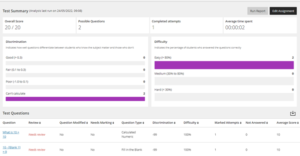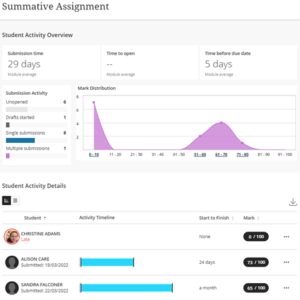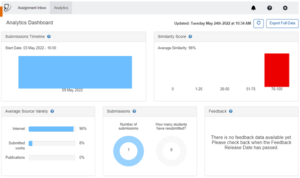In this post, we’ll explore five techniques found within your Blackboard module for analysing student engagement and reviewing the success of your module and assessment design.
We shall explore:
- Module Activity
- Discussion Board Analytics
- Question Analysis
- Assessment Analytics
- And Turnitin Assessment Analytics
Technique No.1 Blackboard Ultra Module Activity
Blackboard Ultra now includes the ability to access analytics relating to activity with a module.
This includes:
- Overall view of student progress in the module presented in various numerical and graphical formats.
- Average hours in module.
- Active hours in module.
- Individual student activity mapped against the class average.

With this data, you can identify and assist students who are working hard but still struggling. You can encourage students to increase their activity in online course materials to help bolster their grade. Using this information, you can congratulate students whose hard work is paying off!
Technique No.2 Blackboard Ultra Discussion Board Analytics
Blackboard Ultra discussion boards include the ability to access analytics relating to student usage and engagement.
Discussion analysis information available includes:
- Active students.
- Average posts per student, word count and discussion grade.
- Participation levels.
- Responses with the most replies.
- Top participants.
- Discussion analysis including lexical variation.
- Group discussion analytics.

Using this information, you can identify and assist students who:
- Are working hard to offer positive feedback
- Students who are not engaging and offer additional support. You can request that students to increase their discussion activity.
Technique No.3 Blackboard Ultra Question Analysis
Blackboard Ultra included a question analysis tool to review questions that your students, as a cohort, answered correctly or struggled with. You can use this to tailor future lessons or adjust quiz questions for future cohorts.
Question Analysis feedback includes:
- Test statistic summary.
- Question differentiation.
- Question difficulty.

Question analysis can provide statistics on overall performance, assessment quality, and individual questions. This information will support the identification of questions that might limit a student’s ability to score highly.
Technique No.4 Blackboard Ultra Assessment Analytics
Blackboard Ultra includes analytics tools for student assessments.
Assessment analysis information includes:
- Student assessment activity overview
- Submission activity
- Activity Timeline
- Start to finish time
- Other time related feedback including accessed after, date opened, date started and start to finish time
- Last accessed

The ability to review student performance and progress is important as it allows the identification of those who are struggling so that supportive action can be taken.
Technique No.5 Turnitin Assignment Analytics
Like the above-mentioned Blackboard Ultra assessment analytic tool, Turnitin analytics can be used for assessments submitted to Turnitin to gauge student participation and success.
Using the Turnitin Analytics Dashboard, you can access:
- Submissions Timeline.
- Similarity Score Ranges.
- Average Source Variety.
- Number of submissions and resubmissions.
- Number of students who viewed didn’t view their feedback.
- Average time before feedback is viewed.
There is also a grading report that will give you an overview of quick mark sets that have been used and how many comments out of each set have been allocated to different students.

